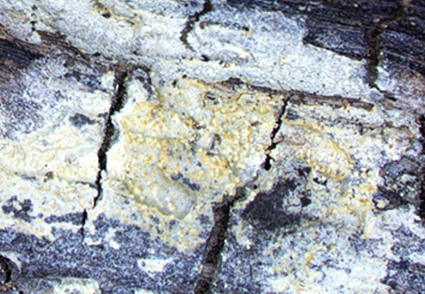Abstract
Saccosoma is a small genus within Atractiellomycetes with only seven described species so far. Most species are very rare and endemic to restricted areas. Saccosoma megasporum is described as a new species from Abies religiosa fallen branches in central Mexico. It is characterized by large, subglobose spores (12–16 × 15–17 µm) and white hypochnoid basidiome. This is the eighth described species of Saccosoma and the second species reported from Mexico. This finding highlights the large corticioid species diversity in Abies religiosa forests (the monarch butterfly overwinter refuge). As this ecosystem is seriously threatened by global warming, its conservation is urgently needed to maintain its fungal diversity and ecosystem services.
References
- Aime, M.C., Urbina, H. Liber, J.A., Bonito, G. & Oono, R. (2018) Two new endophytic Atractiellomycetes, Atractidochium hillariae and Proceropycnis hameedii. Mycologia 110 (1): 136–146. https://doi.org/10.1080/00275514.2018.1446650
- Argüelles-Moyao, A., Garibay-Orijel, R., Márquez-Valdelamar, L.M. & Arellano-Torres, E. (2017) Clavulina-Membranomyces is the most important lineage within the highly diverse ectomycorrhizal fungal community of Abies religiosa. Mycorrhiza 27: 53–65. https://doi.org/10.1007/s00572-016-0724-1
- Baker, G. (1936) A study of the genus Helicogloea. Missouri Botanical Garden 23 (1): 69–128. https://doi.org/10.2307/2399003
- Burrola-Aguilar, C., Garibay-Orijel, R. & Argüelles-Moyao, A. (2013) Abies religiosa forests harbor the highest species density and sporocarp productivity of wild edible mushrooms among five different vegetation types in a neotropical temperate forest region. Agroforestry Systems 87 (5): 1101–1115. https://doi.org/10.1007/s10457-013-9623-z
- Contreras-Pacheco, M.M., Argüelles-Moyao, A. & Garibay-Orijel, R. (2018) Nuevos registros de hongos corticioides asociados a Abies religiosa del Estado de México. Revista Mexicana de Biodiversidad 89: 1–14. https://doi.org/10.22201/ib.20078706e.2018.1.1605
- Darriba, D., Taboada, G.L., Doallo, R. & Posada, D. (2012) jModelTest 2: more models, new heuristics and parallel computing. Natural Methods 9: 772–772. https://doi.org/10.1038/nmeth.2109
- Gardes, M. & Bruns, T.D. (1993) ITS primers with enhanced specificity for basidiomycetes-application for the identification of mycorrhizae and rusts. Molecular Ecology 2: 113–118. https://doi.org/10.1111/j.1365-294X.1993.tb00005.x
- Hopple, J.S. & Vilgalys, R. (1994) Phylogenetic relationships among coprinoid taxa and allies based on data from restriction site mapping of nuclear rDNA. Mycologia 86: 96–107. https://doi.org/10.2307/3760723
- Jülich, W. & Stalpers, J.A. (1980) The resupinate non-poroid Aphyllophorales of the temperate northern hemisphere. North-Holland Publishing Company, Amsterdam, Oxford, New York.
- Katoh, K. & Standley, D.M. (2013) MAFFT Multiple Sequence Alignment Software Version 7: Improvements in Performance and Usability. Molecular Biology and Evolution 30 (4): 772–780. https://doi.org/10.1093/molbev/mst010
- Kisimova-Horovitz, L., Oberwinkler, F. & Gómez, L. (2000) Basidiomicetos resupinados de Costa Rica. Especies nuevas o raras de Atractiellales (Auriculariales s.l.), Exidiaceae, Sirobasidiaceae y Tremellaceae. Revista Biológica Tropical 48 (2/3): 539–554.
- Kornerup, A. & Wanscher, J.H. (1978) Methuen handbook of colour, 3th ed. Eyre Methuen, London.
- Largent, D., Johnson, D. & Watting, R. (1980) How to identify mushrooms to genus III: Microscopic Features. Mad River Press, Scotland.
- Link, J.H.F. (1833) Handbuch zur Erkennung der nutzbarsten und am häufigsten vorkommenden Gewächse 3: 1–536.
- Manzo-Delgado, L., López-García, J. & Alcántara-Ayala, I. (2013) Role of forest conservation in lessening land degradation in a temperate region: the Monarch Butterfly Biosphere Reserve, Mexico. Journal Environmental Management 138: 55–66. https://doi.org/10.1016/j.jenvman.2013.11.017
- Möller, A. (1895) Protobasidiomyceten. Botanische Mitteilungen aus den Tropen 8: 1–180. https://doi.org/10.5962/bhl.title.3752
- Patouillard, N.T. & Lagerheim, G. (1892) Champignons de l’Equateur (Pugillus II). Bulletin de la Société Mycologique de France 8 (2): 113–140.
- Ronquist, F. & Huelsenbeck, J.P. (2003) MRBAYES 3: Bayesian phylogenetic inference under mixed models. Bioinformatics 19: 1572–1574. https://doi.org/10.1093/bioinformatics/btg180
- Spirin, V., Malysheva, V., Trichies, G., Savchenko, A., Põldmaa, K., Nordén, J., Miettinen, O. & Larsson, K.H. (2018) A preliminary overview of the corticioid Atractiellomycetes (Pucciniomycotina, Basidiomycetes). Fungal Systematics and Evolution 2 (1): 311–340. https://doi.org/10.3114/fuse.2018.02.09
- Stamatakis, A. (2014) RAxML version 8: a tool for phylogenetic analysis and post-analysis of large phylogenies. Bioinformatics 30 (9): 1312–1313. https://doi.org/10.1093/bioinformatics/btu033
- Vilgalys, R. & Hester, M. (1990) Rapid genetic identification and mapping of enzymatically amplified ribosomal DNA from several Cryptococcus species. Journal Bacteriology 172: 4238–4246. https://doi.org/10.1128/jb.172.8.4238-4246.1990


